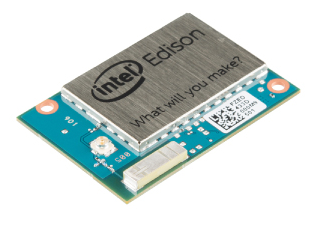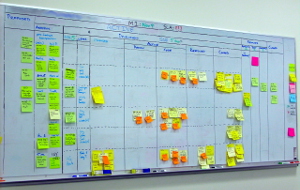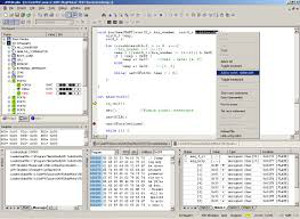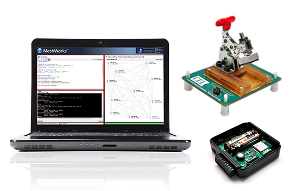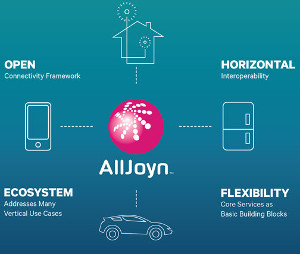Atmel has recently expanded its SmartConnect wireless connectivity portfolio with the announcement of a series of new, turnkey 802.11b/g/n Wi-Fi system-on-chips and modules which are aimed at enabling expanded possibilities in Internet-of-Things, home or building automation and smart energy management as well as smart, connected consumer electronics applications.
The Atmel SmartConnect Wi-Fi family is a range of self-contained, low-power and pre-certified system-on-chips and modules which bring 802.11 wireless LAN connectivity – and access to the Internet – to any embedded system.
These integrated modules offer a great solution for designers seeking to integrate Wi-Fi connectivity without any existing engineering experience with 802.11, real-time operating systems, IP stack concepts nor RF electronics.
Aimed at opening the emerging “Internet of Things”, Atmel’s SmartConnect Wi-Fi portfolio is ready to be integrated in a vast array of battery-powered devices and applications requiring the integration of WLAN connectivity without compromising on cost and power consumption.
Although an active 802.11 radio is more power hungry than some other RF connectivity standards such as Bluetooth Low Energy or 802.15.4/6LoWPAN – the familiarity and existing ubiquitous infrastructure built around the 802.11 wireless LAN standard makes it an attractive choice for many applications, avoiding the need for extra hubs, gateways or cables to be installed to get your devices connected to the Internet.
Atmel’s Wi-Fi system-on-chips are optimised for applications requiring energy efficiency, such as battery-powered devices, with a wide 1.8V to 3.6V supply voltage range, a deep-sleep-mode with less than 20 micro amps of current draw and an architecture that allows for instant switching of the radio on or off or into a sleep state without startup delays.
This allows for battery-powered devices such as portable nodes in wireless sensor networks to be connected to the Internet whilst still retaining extremely good energy efficiency, staying in a sleep state most of the time, waking up several times per day for a moment to collect sensor values and send this data to a server on the Internet before going back to sleep.
Atmel’s SMART SAMW23 Wi-Fi modules are based on Atmel’s low-power Wi-Fi System-on-Chip technology, incorporating WiFi along with an ARM Cortex-M0+ microcontroller core – a fully integrated single-source microcontroller-plus-Wi-Fi radio solution compatible with Atmel Studio 6 and capable of supporting network-connected battery-powered network nodes with a battery lifetime up to years, on a single chip.
This turnkey system provides an integrated software solution, which incorporates application and security protocols such as TLS, an integrated TCP/IP stack and other network services along with a standard real-time operating system.
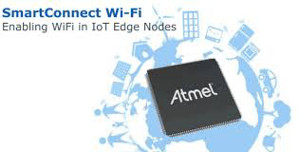
To help you accelerate your development of these kinds of Wi-Fi connected embedded sensor networks and other Internet-of-Things applications, Atmel will be making the SAMW23 Wi-Fi system-on-chip available on one of Atmel’s standard Atmel Xplained evaluation boards which will be able to plug into any other Atmel Xplained Pro microcontroller evaluation board.
Getting started with coding is helped by the SmartConnect library provided by Atmel for use with their SmartConnect range of Wi-Fi hardware – a turnkey software framework that is available for you to use in Atmel Studio 6. It removes the need to understand the Wi-Fi stack, enabling designers to focus on the functionality and user experience of their product.
The Atmel ATWINC1500/ATWILC1000 SmartConnect system-on-chip is a family of IEEE802.11b/g/n network controller and link controller targeted at Internet-of-Things applications, providing valuable solutions for add-on WiFi connectivity in existing microcontroller solutions and product designs, bringing wireless LAN connectivity to your embedded device through a serial UART or SPI interface.
The WINC1500/WILC1000 chipsets connect to any Atmel AVR or SMART microcontroller with minimal resource requirements, and in their most advanced mode of operation these chips support single-stream 1×1 802.11n connectivity providing up to 72 Mbps PHY throughput.
Both devices feature a fully-integrated RF power amplifier, LNA, RF switch and power management system and provide internal Flash memory as well as multiple peripheral interfaces including UART, SPI and I2C.
For the serious enthusiast or less-technical developers, the Arduino team in collaboration with Atmel have recently announced the launch of the Arduino Wi-Fi Shield 101 – an Arduino shield based around the new Atmel ATWINC1500 802.11 network controller, which enables rapid prototyping of wireless, Internet-connected Internet-of-Things applications on the popular open-source Arduino development platform at a relatively low cost.
This cost-effective and secure new Arduino Wi-Fi shield is an easy-to-use extension that can seamlessly be connected to any Arduino board, enabling high-performance Wi-Fi connectivity, giving the Arduino design and developer community more opportunities to securely connect Internet-of-Things applications ranging from consumer appliances to wearable electronics, robotics, or countless other applications where wireless network connectivity is desirable.
And thanks to the open-source nature of the Arduino team’s projects, some leverage can be gained for your own products if using the same open-source licensing model. However the new Atmel wireless platform holds great promise for developers of IoT-enabled hardware. And that includes the engineering team here at the LX Group – who can bring your ideas to life.
Getting started is easy – join us for an obligation-free and confidential discussion about your ideas and how we can help bring them to life – click here to contact us, or telephone 1800 810 124.
LX is an award-winning electronics design company based in Sydney, Australia. LX services include full turnkey design, electronics, hardware, software and firmware design. LX specialises in embedded systems and wireless technologies design.
Published by LX Pty Ltd for itself and the LX Group of companies, including LX Design House, LX Solutions and LX Consulting, LX Innovations.


